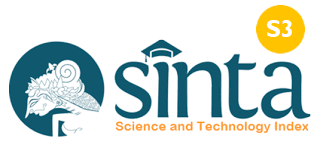Pengembangan Media Pembelajaran Ekonomi dengan Pendekatan Contextual Teaching and Learning Berbasis Google Sites di Moderasi Literasi Digital untuk Meningkatkan Hasil Belajar Siswa Kelas XI IPS SMA Swasta ST Ignasius Medan T.P 2023/2024
DOI:
https://doi.org/10.37329/cetta.v7i3.3378Keywords:
Learning Media, Contextual Teaching and Learning, Digital Literacy, Learning OutcomesAbstract
The limited digital media available is one of the obstacles in maximizing the learning process. Based on initial observations, researchers found that there were problems with the academic performance of Medan High School Class This research aims to develop media in digital form based on CTL with digital literacy level as a moderating variable to improve economic learning outcomes at Santo Ignasius High School Medan Class XI IPS 1. This research uses a more general learning design model, namely the ADDIE model. This development model has five stages, namely: Analysis, Design, Development, Implementation and Evaluation (ADDIE). This research was carried out at SMA Santo Ignasius Medan with a population of 36 students. Based on the feasibility validation test for CTL-based digital media carried out by experts, the average result was 86.13% with a very feasible category. The post-test score obtained by the experimental class which was processed with the developed CTL-based digital media was an average of 89.59, while the post-test score for the control class obtained a school average of 86.56. Therefore, it can be concluded that the digital media developed based on CTL is effectively applied to improve the learning outcomes of class XI IPS 1 SMA Santo Ignasius Medan to be applied to classroom learning.
References
A’yuni, Q.Q. (2015). Literasi Digital Remaja Di Kota Surabaya. Jurnal Fakultas Ilmu Sosial Dan Ilmu Politik Universitas Airlangga Surabaya 4(2), 224–39.
Abidin, Z. (2020). Efektivitas Pembelajaran Berbasis Masalah, Pembelajaran Berbasis Proyek Literasi, Dan Pembelajaran Inkuiri Dalam Meningkatkan Kemampuan Koneksi Matematis. Jurnal Profesi Pendidikan Dasar 7(1), 37–52.
Afrianti, R. E.N., Qohar, A. (2019). Pengembangan E-Modul Berbasis Kontekstual Pada Materi Program Linear Kelas XI. Jurnal Edukasi Matematika Dan Sains 7(1), 22-29.
Sudarman, F. R., Partha, M. N. (2021). Pengembangan E-Modul Pembelajaran Ekonomi Berbasis Colt Di Sma Negeri 5 Samarinda. Jurnal Prospek: Pendidikan Ilmu Sosial Dan Ekonomi 3(2), 12–21.
Fatria, F., Listari. (2017). Penerapan Media Pembelajaran Google Drive Dalam. Jurnal Penelitian Bahasa Dan Sastra 2(1), 138–44.
Frydenberg, M., Andone, D. (2011). Learning for 21st Century Skills. Pp. 312–18 in IEEE’s International Conference on Information Society.
Hamdani, A. (2021). Pengembangan Media Pembelajaran Berbasis Website Menggunakan Google Sites Pada Materi Sistem Gerak Manusia Untuk Peserta Didik Kelas VIII SMP/MTs.
Hasudungan, A.N. (2022). Pembelajaran Contextual Teaching Learning (CTL) Pada Masa Pandemi COVID-19: Sebuah Tinjauan. Jurnal DinamikA 3(2), 112–26.
Hosnan. (2016). Pendekatan Saintifik Dan Konstektual Dalam Pembelajaran Abad 21. Bogor: Ghalia Indonesia.
Martin., Syamsuri., Pujiastuti, H., Hendrayana, A. (2021). Pengembangan E-Modul Berbasis Pendekatan Contextual Teaching And Learning Pada Materi Barisan Dan Deret Untuk Meningkatkan Minat Belajar Siswa SMP. Jurnal Derivat: Jurnal Matematika Dan Pendidikan Matematika 8(2), 72–87.
Moto, M. M. (2019). Pengaruh Penggunaan Media Pembelajaran Dalam Dunia Pendidikan. Indonesian Journal of Primary Education 3(1), 20–28.
Naufal, H. A. (2021). Literasi Digital. Jurnal Perspektif 1(2), 195–202.
Nurhidayati, V. N., Ramadani, F., Melisa, F., Putri, D. A. (2023). Penerapan Media Pembelajaran Terhadap Motivasi Siswa. Jurnal Binagogik 10(2), 99–106.
Pambudi, M. A., Windasari. (2022). Strategi Guru Dalam Meningkatkan Literasi Digital Pada Siswa. Jurnal Inspirasi Manajemen Pendidikan 10(3), 636–46.
Ristadi, F. A., Ngadiyono, Y. (2017). Pengembangan Model Pembelajaran Berbasis CTL Untuk Meningkatkan Kompetensi Menggambar Berbantuan Komputer (CAD) Siswa SMK. Jurnal Dinamika Vokasional Teknik Mesin 2(1), 73-81.
Sapriyah. (2019). Peran Media Pembelajaran Dalam Proses Belajar Mengajar. Pp. 470–77 in Prosiding Seminar Nasional Pendidikan FKIP. Vol. 2.
Sari, D. R., Fikroh, R. A., Rahayu, R., Ridzaniyanto, P. (2022). Pengembangan Media Pembelajaran Google Sites Pada Materi Hidrolisis Garam Berbasis Pendekatan Kontekstual. Lantanida Journal 10(2), 109-123.
Serevina, V., Raihanati, S., Astra, I. M., Sari, I. J. (2018). Development of E-Module Based on Problem Based Learning (PBL) on Heat and Temperature to Improve Student’s Science Process Skill. Turkish Online Journal of Educational Technology 17(3), 26–36.
Setiawan, K., Naomi, S., Winata, W. (2022). Pengembangan Desain Media Pembelajaran Berbasis Google Sites Kepada Guru Pada Pembelajaran Daring Di SMP Islam Harapan Ibu Jakarta-Selatan. Jurnal Instruksional 4(1), 73–82.
Sidabutar, M. J., Sidabutar, N. A. L. (2024). Development of Animated Videos with the Doratoon Application on Trade Materials Between Region and Countries. Pakar Pendidikan 21(1), 88–98.
Sidabutar, N. A. L.,Reflina (2022). Pengembangan Media Pembelajaran Matematika Sma Dengan Aplikasi Animaker Pada Materi Vektor. Jurnal Cendekia : Jurnal Pendidikan Matematika 6(2), 1374–1386.
Suprihatiningrum, J. (2017). Strategi Pembelajaran. Yogyakarta: Ar-ruzz Media.
Tanjung, R. E., Faiza, D. (2019). Canva Sebagai Media Pembelajaran Pada Mata Pelajaran Dasar Listrik Dan Elektronika. Jurnal Voteteknika (Vocational Teknik Elektronika Dan Informatika) 7(2), 79-85.
Wulandari, A. P., Salsabila, A. A., Cahyani, K., Nurazizah, T. S., Ulfiah, Z. (2023). Pentingnya Media Pembelajaran Dalam Proses Belajar Mengajar. Journal on Education 5(2), 3928–3936.
Downloads
Published
How to Cite
Issue
Section
License
Copyright (c) 2024 Esti Julianita Ginting, Eko Wahyu Nugrahadi, Zulkarnain Siregar

This work is licensed under a Creative Commons Attribution-ShareAlike 4.0 International License.
An author who publishes in the Cetta : Jurnal Ilmu Pendidikan agrees to the following terms:
- Author retains the copyright and grants the journal the right of first publication of the work simultaneously licensed under the Creative Commons Attribution-ShareAlike 4.0 License that allows others to share the work with an acknowledgement of the work's authorship and initial publication in this journal
- Author is able to enter into separate, additional contractual arrangements for the non-exclusive distribution of the journal's published version of the work (e.g., post it to an institutional repository or publish it in a book) with the acknowledgement of its initial publication in this journal.
- Author is permitted and encouraged to post his/her work online (e.g., in institutional repositories or on their website) prior to and during the submission process, as it can lead to productive exchanges, as well as earlier and greater citation of the published work (See The Effect of Open Access).
Read more about the Creative Commons Attribution-ShareAlike 4.0 Licence here: https://creativecommons.org/licenses/by-sa/4.0/.





